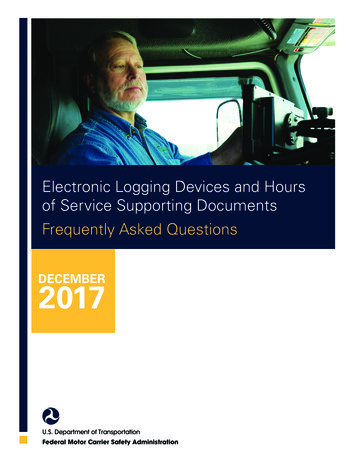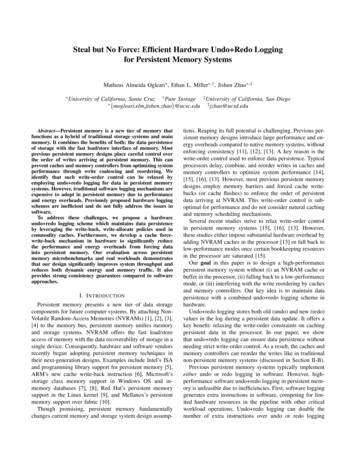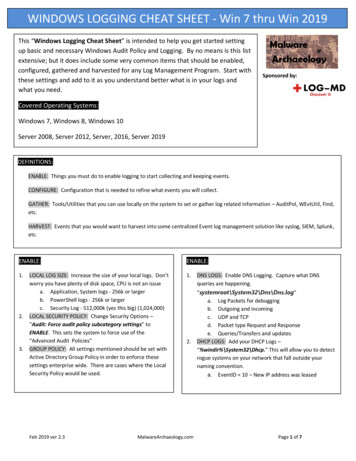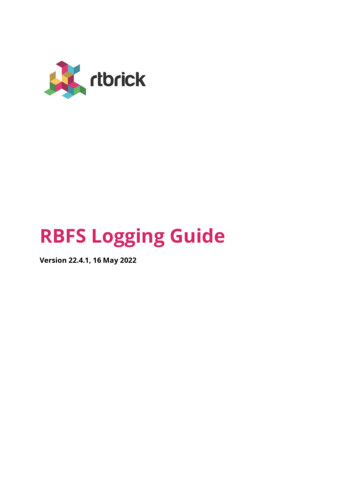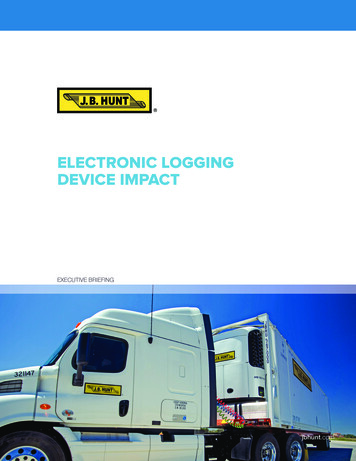
Transcription
ELECTRONIC LOGGINGDEVICE IMPACTEXECUTIVE BRIEFINGjbhunt.com
THE ELD MANDATEAT-A-GLANCEDRIVERS AND CARRIERS HAVE UNTIL DECEMBER 18, 2017, TO COMPLY.3 MILLIONSHORT TERMESTIMATED DRIVERS CURRENTLY UNDERPAPER LOGS AND MUST CONVERT TO AN ELD.RATES MAY INCREASE IF CAPACITY DECREASESWHEN HOS VIOLATORS BECOME COMPLIANT.J.B. HUNT TRUCKSARE ELD COMPLIANT
ELECTRONIC LOGGINGDEVICE IMPACTThe U.S. Department of Transportation’s Federal Motor Carrier SafetyAdministration (FMCSA) announced on Dec. 10, 2015, that motorcarriers would have to begin using electronic logging devices (ELDs) onall trucks and commercial buses manufactured after 2000. BeginningDec. 18, 2017, drivers and carriers will be required to comply with ELDregulations. Those who are currently using automatic onboard recordingdevices (AOBRDs) or install them before the December deadline will begrandfathered in. They will have an additional two years to update toELD-compliant technology.On Aug. 21, 2017, the Commercial Vehicle Safety Alliance (CVSA)announced that the out-of-service criteria associated with the ELDmandate will go into effect April 1, 2018. Before April 1, ELD violationswill be documented on roadside inspection reports, and fines orcitations may be issued at the jurisdiction’s discretion. After April 1, lawenforcement or inspectors can place trucks out of service for violatingELD regulations.1The ELD mandate is designed to increase commercial motor vehiclesafety, reduce industry paperwork, and improve Hours of Service (HOS)compliance. The FMCSA considers ELD records “the most robust formof documentation for on-duty driving periods.” Some drivers currentlyuse paper logbooks to report HOS; however, the ELDs will replace paperlogbooks. Additionally, law enforcement or inspectors will be able to usethe data to review driver records more efficiently. Not only do driversneed to have this technology installed on their trucks by the applicabledeadlines, they must also know how to use it.Commercial motor vehicle drivers who operate under the short-haulexemption do not have to comply with this mandate. Per the FMCSA, ashort-haul driver “operates within a 100-air-mile radius of the normal workreporting location.” Drivers under this classification are exempt unlesstheir duties require them to complete a log for more than eight days ina 30-day period. Additional exemptions include drivers of driveaway-towaway vehicles, trucks that were manufactured before 2000, and shortterm rental trucks operating eight or fewer days.2 A temporary waiver isin-place for drivers hauling agriculture commodities.
CAPACITYThe approximately three million drivers,3or 67% of the impacted driver populationwho are currently using paper logs, mayexperience decreased capacity when theyswitch to electronic logs. Carriers whosedrivers have not been compliant with theHOS regulations will see the biggest impacton their capacity. It is estimated that driverswho have been operating beyond the legalhours could see a double-digit reduction inproductivity.3Although this new regulation will affectmillions of drivers, the long-term benefits ofthe ELD mandate outweigh the preliminarycost. Many larger companies have alreadyincurred the cost of ELDs, which is around 500 per truck, per year. Smaller carriers andowner-operators will incur a similar expenseas they implement ELDs. The FMCSA saysELDs will save the industry more than 3billion annually through reduced paperworkand fewer highway crashes, which includesa savings of 2.4 billion and 572 millionrespectively.4 Even after adjusting for thecosts of equipment, compliance, andtraining, the net benefit of ELDs is still morethan 1 billion.*In addition to the monetary savings theindustry will receive, the ruling will alsoallow fleet managers to benefit from morevisibility and control of their fleets. TheJ.B. Hunt white paper, “660 Minutes: HowImproving Driver Efficiency IncreasesCapacity,” contains additional informationfor customers about the HOS regulationand how drivers and carriers can maximizeefficiency within that regulation.
BENEFITSThe ELD mandate will make it more difficult for drivers to misrepresent their driving time, thus reducingHOS violations. By enforcing HOS regulations, this new mandate should reduce driver fatigue and preventapproximately 26 fatalities and more than 500 injuries per year.5ELDs will increase HOS compliance by making it easier for drivers to keep accurate logs. It will also helpmanagers and support staff better improve enforcement of HOS and cut down on paperwork. Because ELDsrecord location, time, and available hours, management can better help drivers improve productivity. Themandate will also reduce liability due to fewer crashes by fatigued drivers.SHIPPERSAlthough most large carriers have already been using ELDs or AOBRDs, many smaller carriers will have tooverhaul how their drivers maintain their record of duty. Rates for smaller carriers may increase if equipmentutilization decreases.The Owner-Operator Independent Drivers Association (OOIDA) opposes the mandate and has filed suitsagainst the FMCSA. One concern from smaller carriers is that this mandate will put too much pressure ondrivers. According to the OOIDA, motor carriers have already used ELDs to harass drivers. This includesforcing them to log non-driving times when they are still on duty as “off-duty” and reducing driver sleepingperiods in the sleeper berth by using the ELD to wake them.6However, part of this new rule mandates that motor carriers or shippers cannot use data from the ELDs tocoerce or harass drivers into violating HOS rules. If a driver feels a shipper or carrier is pressuring him or herto violate the HOS regulations, he or she can file a complaint with the FMCSA.The ELD mandate is a step in the right direction to keep our roads safe. More information about this mandatecan be found online at https://www.fmcsa.dot.gov.1. /2. waiver-short-term-truck-rentals3. ld-era-shippers-brace-disruption 20171201.html4. 15-31336.pdf5. d-bus-industries6. S.asp*The figures are annualized using 7% discount rates, per FMCSA.
jbhunt.comITITEM SAL-1412
ELECTRONIC LOGGING DEVICE IMPACT The U.S. Department of Transportation's Federal Motor Carrier Safety Administration (FMCSA) announced on Dec. 10, 2015, that motor carriers would have to begin using electronic logging devices (ELDs) on all trucks and commercial buses manufactured after 2000. Beginning

